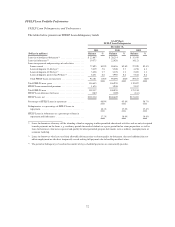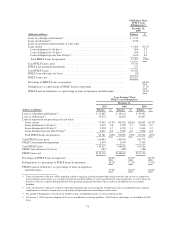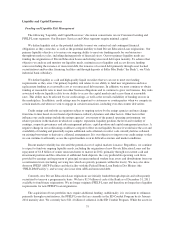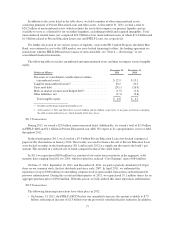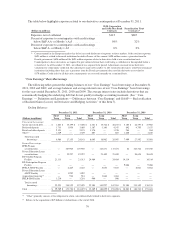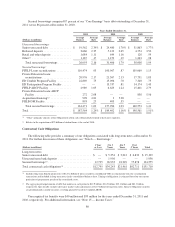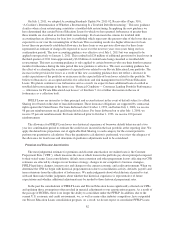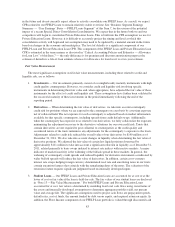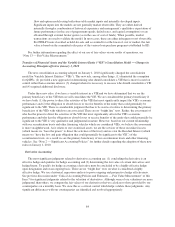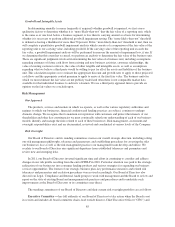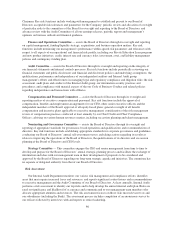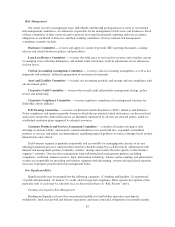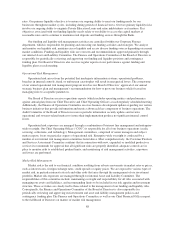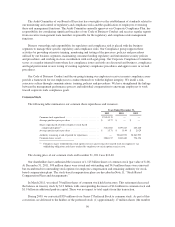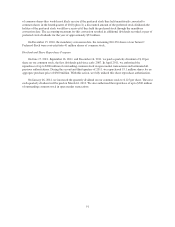Sallie Mae 2011 Annual Report Download - page 84
Download and view the complete annual report
Please find page 84 of the 2011 Sallie Mae annual report below. You can navigate through the pages in the report by either clicking on the pages listed below, or by using the keyword search tool below to find specific information within the annual report.On July 1, 2011, we adopted Accounting Standards Update No. 2011-02, Receivables (Topic 310),
“A Creditor’s Determination of Whether a Restructuring Is a Troubled Debt Restructuring.” This new guidance
clarifies when a loan restructuring constitutes a troubled debt restructuring. In applying the new guidance we
have determined that certain Private Education Loans for which we have granted forbearance of greater than
three months are classified as troubled debt restructurings. If a loan meets the criteria for troubled debt
accounting then an allowance for loan loss is established which represents the present value of the losses that are
expected to occur over the remaining life of the loan. This accounting results in a higher allowance for loan
losses than our previously established allowance for these loans as our previous allowance for these loans
represented an estimate of charge-offs expected to occur over the next two years (two years being our loss
confirmation period). The new accounting guidance was effective as of July 1, 2011 but was required to be
applied retrospectively to January 1, 2011. This resulted in $124 million of additional provision for loan losses in
the third quarter of 2011 from approximately $3.8 billion of student loans being classified as troubled debt
restructurings. This new accounting guidance is only applied to certain borrowers who use their fourth or greater
month of forbearance during the time period this new guidance is effective. This new accounting guidance has
the effect of accelerating the recognition of expected losses related to our Private Education Loan portfolio. The
increase in the provision for losses as a result of this new accounting guidance does not reflect a decrease in
credit expectations of the portfolio or an increase in the expected life-of-loan losses related to this portfolio. We
believe forbearance is an accepted and effective collections and risk management tool for Private Education
Loans. We plan to continue to use forbearance and as a result, we expect to have additional loans classified as
troubled debt restructurings in the future (see “Financial Condition — Consumer Lending Portfolio Performance
— Allowance for Private Education Loan Losses” of this Item 7. for a further discussion on the use of
forbearance as a collection tool).
FFELP Loans are insured as to their principal and accrued interest in the event of default subject to a Risk
Sharing level based on the date of loan disbursement. These insurance obligations are supported by contractual
rights against the United States. For loans disbursed after October 1, 1993, and before July 1, 2006, we receive
98 percent reimbursement on all qualifying default claims. For loans disbursed on or after July 1, 2006, we
receive 97 percent reimbursement. For loans disbursed prior to October 1, 1993, we receive 100 percent
reimbursement.
The allowance for FFELP Loan losses uses historical experience of borrower default behavior and a two
year loss confirmation period to estimate the credit losses incurred in the loan portfolio at the reporting date. We
apply the default rate projections, net of applicable Risk Sharing, to each category for the current period to
perform our quantitative calculation. Once the quantitative calculation is performed, we review the adequacy of
the allowance for loan losses and determine if qualitative adjustments need to be considered.
Premium and Discount Amortization
The most judgmental estimate for premium and discount amortization on student loans is the Constant
Prepayment Rate (“CPR”), which measures the rate at which loans in the portfolio pay down principal compared
to their stated terms. Loan consolidation, default, term extension and other prepayment factors affecting our CPR
estimates are affected by changes in our business strategy, changes in our competitor’s business strategies,
FFELP legislative changes, interest rates and changes to the current economic and credit environment. When we
determine the CPR we begin with historical prepayment rates due to consolidation activity, defaults, payoffs and
term extensions from the utilization of forbearance. We make judgments about which historical period to start
with and then make further judgments about whether that historical experience is representative of future
expectations and whether additional adjustment may be needed to those historical prepayment rates.
In the past the consolidation of FFELP Loans and Private Education Loans significantly affected our CPRs
and updating those assumptions often resulted in material adjustments to our amortization expense. As a result of
the passage of HCERA, there is no longer the ability to consolidate under the FFELP. In addition, due to the
current U.S. economic and credit environment, we, as well as many other industry competitors, have suspended
our Private Education Loans consolidation program. As a result, we do not expect to consolidate FFELP Loans
82


